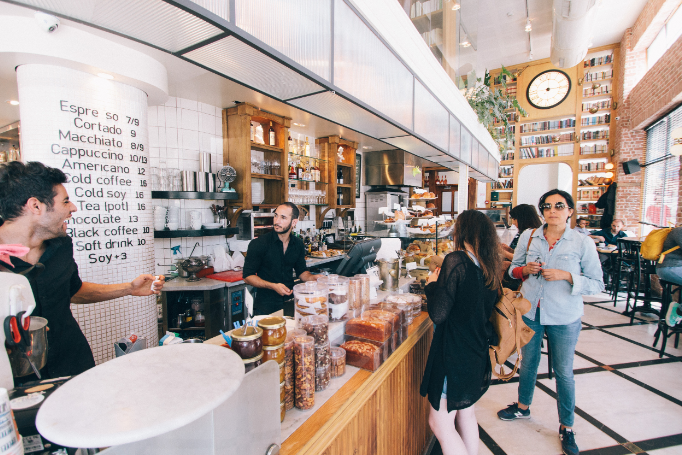Americans are eating out more than ever according to a recent Nielsen report. New research suggest Americans on average spend around $70,000 on takeout and delivery alone during their lifetime. This data, combined with a strong customer price index, suggest 2018 will be a strong year for the restaurant industry. This is great news for restaurant executives. Especially true for large restaurants chains and franchises who have the right mix of technology and software at their fingertips to make critical business decisions backed by sound data.
So what is the ideal restaurant management software for emerging chains and franchise restaurants in 2018? When it comes to answering this question let’s first dive into the fundamental software applications needed for running a successful restaurant operation.
At a high level, restaurant management software enables restaurant managers and executives to organize their back office operations. These applications are used by the restaurant employees to place orders, track inventory, generate payroll, and provide reporting & analysis on restaurant performance.
The key components of Restaurant Management Software include the following:
- Point of Sale (POS) – Is a combination of software and hardware that allows retail locations to conduct sales transactions. Some POS systems have features related to customer interactions, but generally focuses on behind-the-scenes processes such as accounting, processing payments, inventory management, and employee scheduling.
- Financial/Accounting Management – Includes your general ledger, manages payables and receivables, compare financials versus budget, and produces financial statements.
- Inventory management – Track and management stock levels and provide inventory reports.
- Labor management – Track and manage employee schedules, calculate labor expenses, and manage compliance with regulations.
Recent Trends In Restaurant Technology…
CLOUD COMPUTING
The rise in cloud computing has enabled all businesses to reallocate IT related expense and reduce cost while providing a better service to customers and employees. This is especially true in the restaurant business. Furthermore, cloud computing has enabled software vendors to push out new applications and updates at lightning speed that address various areas of the restaurant business. Common examples include POS, Customer Loyalty, Reservation Management, etc.
As a consumer having more options at a lower price point is generally a good thing, however you’ll want to have a solid understand software interconnectivity and use across platforms, prior to signing on with new software vendor. It would be a shame to spend time and money deploying a new application only to find yourself bogged down with a surprise integration project.
CENTRALIZED PROCESSING
Another trend in the restaurant space has to do with centralized production and distribution for multi unit and franchise companies. Business executives love the idea of lowering cost and increasing production through the use of a centralized kitchen and/or warehouses however the reality of managing this complexity can easily overwhelm restaurant executives especially without the proper technology in place. Otherwise you may find yourself in the same predicament as Chipotle during their E. coli outbreak that caused several store shutdowns and created their first revenue losses in a decade. Since then they have adopted technology that is able to trace a single piece of produce back to the packing house from which it was shipped or to the field in which it grew. This level of traceability is a necessary for today’s complex food supply chains especially for those looking to scale their business with centralized processing.
MILLENNIAL INFLUENCE
Millennials love technology. Its second nature to them. Like most industries, millennials have disrupted the restaurant industry. For example, millennials single handedly have influenced how orders are placed, the checkout & delivery process and how reservations are captured and managed. Did you know that online ordering exceeded orders captured over the telephone for the first time ever in 2017, In fact, online ordering has tripled over the past five years. Millennials love the control they have over their meal preferences all at their fingertips. The degree to which you can execute on an omnichannel (web, store, phone) experience will have a direct impact on your top line.
To meet these demands and others , the ideal restaurant management software is one that has strong capabilities around inventory management, customer loyalty, staff management and point of sale that is tightly integrated with an enterprise view of financials, transactions and customers. NetSuite, the leading cloud-based ERP provider recently teamed up with Benseron, the leading POS for restaurants to provide just this type of solution for large chains and franchise restaurants looking for a tightly integrated front end and back end.. The founder at Benseron was recently quoted with the release of their Linga POS:
“Linga POS provides a consistent and easy to use interface to manage the day to day operations for franchise businesses, while collecting valuable customer data. Integrating Linga with NetSuite ERP synchronizes data between both systems for critical decision making at the store, region, and enterprise level,” says Benseron Hospitality CEO Onur Haytac.
Does your emerging restaurant business have the right technology in place to meet the demands of your customers, vendors and management team? If not, what’s holding you back?
Ready to act on the latest restaurant tech trends? Explore your pricing options and see how Cumula 3 Group can support your chain or franchise.






